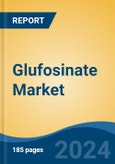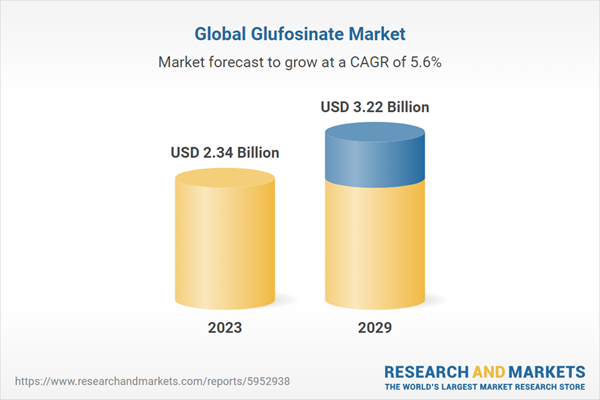Free Webex Call
Global Glufosinate Market was valued at USD 2.34 billion in 2023 and is anticipated to project robust growth in the forecast period with a CAGR of 5.64% through 2029. The global glufosinate market has witnessed substantial growth in recent years, driven by increasing demand for effective herbicides in agriculture and non-agriculture sectors. Glufosinate, a broad-spectrum herbicide, is widely utilized to control weeds in various crops such as corn, soybeans, cotton, and fruits. Its applications in non-agricultural settings like forestry, turf, and ornamentals contribute significantly to market expansion. Speak directly to the analyst to clarify any post sales queries you may have.
10% Free customizationThis report comes with 10% free customization, enabling you to add data that meets your specific business needs.
With the global population steadily increasing, there is a growing demand for food production. Glufosinate aids in improving crop yield by effectively managing weed growth, thus catering to the escalating food demand.
Prolonged use of glufosinate has led to the development of weed resistance in certain regions, necessitating the adoption of integrated weed management practices. Effective resistance management strategies are vital to sustain the long-term efficacy of glufosinate-based herbicides.
The global glufosinate market presents lucrative opportunities for stakeholders across agricultural and non-agricultural sectors, driven by the growing need for efficient weed management solutions amidst evolving market dynamics and regulatory landscapes.
Key Market Drivers
Growth in Agriculture Industry
Glufosinate, a broad-spectrum herbicide, has garnered considerable attention within the agricultural community owing to its effectiveness in controlling a wide range of weeds. Its mode of action disrupts the plant's ability to produce essential amino acids, leading to rapid and efficient weed control. Glufosinate exhibits favorable environmental characteristics, such as low persistence and soil mobility, making it a preferred choice among farmers seeking sustainable weed management solutions.Regions experiencing rapid agricultural development, such as Asia-Pacific, Latin America, and parts of Africa, have emerged as key growth drivers for the glufosinate market. The adoption of modern farming practices coupled with increasing farm sizes in these regions has spurred the uptake of herbicidal solutions to ensure efficient weed management and maximize crop productivity.
As agricultural practices evolve to meet the demands of a burgeoning population and changing climatic conditions, the need for efficient weed management solutions becomes increasingly pronounced. Against this backdrop, glufosinate emerges as a pivotal tool in the arsenal of modern farmers, driving sustained growth and innovation within the agrochemical sector.
Surge in Technological Advancements
In recent years, the global agricultural industry has witnessed a remarkable surge in technological advancements, revolutionizing traditional farming practices and propelling the demand for innovative agricultural inputs. Amidst this transformative landscape, one notable driver of market growth is the increasing adoption of advanced herbicides, particularly glufosinate.One of the primary factors fueling the demand for glufosinate is its compatibility with modern agricultural practices, including precision farming and genetically modified (GM) crop cultivation. Technological advancements have facilitated the development of glufosinate-resistant crop varieties, enabling farmers to effectively manage weed populations while safeguarding crop yields. The advent of precision application technologies, such as drones and autonomous machinery, has enhanced the efficiency and accuracy of herbicide application, further driving the uptake of glufosinate-based products.
Advancements in formulation technologies have led to the creation of highly concentrated and environmentally friendly formulations of glufosinate, addressing concerns regarding environmental impact and minimizing the risk of off-target damage. These innovations have positioned glufosinate as a preferred choice among farmers seeking sustainable and cost-effective weed management solutions.
Key Market Challenges
Volatility in Prices of Glufosinate
One of the primary drivers of glufosinate price volatility is the cost of raw materials used in its production. The prices of key ingredients, such as phosphorus, ammonia, and phosphorus trichloride, are subject to fluctuations due to factors such as geopolitical tensions, currency exchange rates, and supply-demand imbalances. Any disruption in the supply chain or unexpected price spikes can ripple through to the final cost of glufosinate, impacting market stability.Speculative trading and market sentiment play pivotal roles in shaping the volatility of the glufosinate market. Investor sentiments regarding future demand, crop conditions, and geopolitical events wield significant influence over trading dynamics, thereby amplifying price fluctuations. Discrepancies between supply and demand, compounded by unforeseen variables like weather anomalies or pest outbreaks, inject a considerable degree of uncertainty into pricing mechanisms, further exacerbating market volatility. It is imperative for stakeholders to monitor these factors diligently and implement strategic measures to mitigate the adverse effects of such volatility on market stability and profitability.
Key Market Trends
Growing Shift towards Sustainable Agriculture
Rising awareness about environmental degradation and the need for conservation has prompted stakeholders in the agriculture sector to adopt practices that reduce chemical inputs and minimize pollution. Sustainable agriculture practices, including the use of environmentally friendly herbicides like glufosinate, align with these concerns by promoting biodiversity, soil health, and water quality.Consumer preferences are exerting an ever-expanding influence on market dynamics, particularly with the rising clamor for sustainably sourced food products. Today's consumers are acutely aware of the environmental and social ramifications of their purchasing choices, thus propelling a surge in the desire for goods cultivated through sustainable agricultural methods. Glufosinate, when employed prudently within an integrated pest management framework, empowers farmers to cultivate crops of exceptional quality while aligning with consumer demands for sustainability. By leveraging such practices, producers can not only meet the evolving expectations of environmentally-conscious consumers but also enhance their market positioning and long-term viability.
Segmental Insights
Form Insights
Based on the category of form, the liquid emerged as the fastest growing segment in the global market for glufosinate in 2023. Liquid formulations often offer ease of application compared to granular or powdered forms. Farmers can use sprayers to apply liquid herbicides more precisely and uniformly across their fields, leading to better weed control and potentially higher crop yields. Liquid formulations better efficacy compared to other forms of herbicides. They can penetrate plant tissues more effectively, leading to quicker and more thorough weed control.Application Insights
The agricultural segment is projected to dominate the market during the forecast period. Glufosinate is widely used as an herbicide in agriculture to combat a broad spectrum of weeds that vie with crops for vital resources like nutrients, water, and sunlight. Its proven effectiveness in weed management positions it as an indispensable tool for farmers seeking to optimize yields and ensure the high quality of their produce.Regional Insights
North America emerged as the dominant player in the Global Glufosinate Market in 2023, holding the largest market share in terms of both value and volume. North America boasts a substantial agricultural sector, with extensive areas dedicated to crop cultivation. The region's vast farmland provides a significant market for herbicides like glufosinate.North America is at the forefront of agricultural innovation, with advanced farming practices, machinery, and technologies widely adopted across the continent. The integration of precision agriculture techniques, including the use of genetically modified crops resistant to glufosinate, has contributed to the high demand for this herbicide in the region.
Report Scope:
In this report, the Global Glufosinate Market has been segmented into the following categories, in addition to the industry trends which have also been detailed below:Glufosinate Market, By Crop Type:
- Genetically Modified Crops
- Conventional Crops
Glufosinate Market, By Application:
- Agricultural
- Non-Agricultural
Glufosinate Market, By Form:
- Liquid
- Dry
Glufosinate Market, By Region:
- North America
- United States
- Canada
- Mexico
- Europe
- France
- United Kingdom
- Italy
- Germany
- Spain
- Asia Pacific
- China
- India
- Japan
- Australia
- South Korea
- South America
- Brazil
- Argentina
- Colombia
- Middle East Africa
- South Africa
- Saudi Arabia
- UAE
Competitive Landscape
Company Profiles: Detailed analysis of the major companies present in the Global Glufosinate Market.Available Customizations:
Global Glufosinate Market report with the given market data, the publisher offers customizations according to a company's specific needs.This product will be delivered within 1-3 business days.
Table of Contents
1. Product Overview
2. Research Methodology
3. Executive Summary
5. Global Glufosinate Market Outlook
6. Asia Pacific Glufosinate Market Outlook
7. Europe Glufosinate Market Outlook
8. North America Glufosinate Market Outlook
9. South America Glufosinate Market Outlook
10. Middle East and Africa Glufosinate Market Outlook
11. Market Dynamics
12. Market Trends Developments
14. Porter’s Five Forces Analysis
16. Competitive Landscape
Companies Mentioned
- Bayer AG
- DuPont de Nemours, Inc.
- Syngenta Crop Protection AG
- UPL LTD
- Nufarm Limited
- Jiangsu Huangma Agrochemicals Co., Ltd
- BASF SE
- Hebei Veyong Bio-Chemical Co. Ltd
- ZHEJIANG YONGNONG CHEM. IND. CO., LTD
- Clariant AG
Table Information
| Report Attribute | Details |
|---|---|
| No. of Pages | 185 |
| Published | April 2024 |
| Forecast Period | 2023 - 2029 |
| Estimated Market Value ( USD | $ 2.34 Billion |
| Forecasted Market Value ( USD | $ 3.22 Billion |
| Compound Annual Growth Rate | 5.6% |
| Regions Covered | Global |
| No. of Companies Mentioned | 10 |









